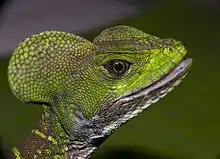| Western basilisk | |
|---|---|
 | |
| The head of a western basilisk. | |
| Scientific classification | |
| Domain: | Eukaryota |
| Kingdom: | Animalia |
| Phylum: | Chordata |
| Class: | Reptilia |
| Order: | Squamata |
| Suborder: | Iguania |
| Family: | Corytophanidae |
| Genus: | Basiliscus |
| Species: | B. galeritus |
| Binomial name | |
| Basiliscus galeritus A.M.C. Duméril & A.H.A. Duméril, 1851 | |
The western basilisk, or red-headed basilisk (Basiliscus galeritus), is a large species of lizard in the family Corytophanidae. The species is endemic to northwestern South America.
Etymology
The specific name, galeritus, which is Latin, means "wearing a hood", referring to the head crest.[2]
Habitat and geographic range
B. galeritus inhabits forests at altitudes of 0–1,600 m (0–5,249 ft) in western Colombia and western Ecuador in South America.[3] Earlier reports of its occurrence in Central America are mistaken and actually refer to young of the closely related common basilisk.[4][5]
Conservation status
The western basilisk is common and not threatened.[3]
Description
Males of B. galeritus reach a total length (including tail) up to about 77.5 cm (30.5 in), while females reach about 63.5 cm (25.0 in).[3] Its body color is olive-green with a reddish-brown underbelly. The throat is white to yellow. On the back it has a small crest similar to that of young individuals of the common basilisk. It may have a narrow white stripe or a row of white dots on each side. It has no back flap. The adult males bear a round head flap/crest.
Invasive species
The western basilisk has been introduced to Gorgona Island, Colombia. This species is not native to the island, and thus, is endangering native species that reside on the island, such as the endemic blue anole (Anolis gorgonae).
References
- ↑ Ibáñez, R.; Jaramillo, C.; Arredondo, J.C.; Cisneros-Heredia, D.F. (2019). "Basiliscus galeritus". IUCN Red List of Threatened Species. 2019: e.T203045A151731207. doi:10.2305/IUCN.UK.2019-2.RLTS.T203045A151731207.en. Retrieved 20 November 2021.
- ↑ "Basiliscus galeritus ". The Reptile Database. www.reptile-database.org.
- 1 2 3 Bustamante-Enríquez LM, Arteaga AF (2012). Western Basilisk (Basiliscus galeritus). The Amphibians and Reptiles of Mindo. Version 2012.a
- ↑ Savage JM (2002). The Amphibians and Reptiles of Costa Rica: A Herpetofauna between Two Continents, between Two Seas. Chicago and London: University of Chicago Press. 954 pp. ISBN 0-226-73537-0. p. 429.
- ↑ Köhler G (2000). Reptilien und Amphibien Mittelamerikas, Band 1: Krokodile, Schildkröten, Echsen [Central American Reptiles and Amphibians, Volume 1: Crocodiles, Turtles, Lizards]. Offenbach, Germany: Herpeton. 158 pp. ISBN 3-9806214-0-5. p. 72. (in German).
External links
Further reading
- Boulenger GA (1885). Catalogue of the Lizards in the British Museum (Natural History). Second Edition. Volume II. Iguanidæ ... London: Trustees of the British Museum (Natural History). (Taylor and Francis, printers). xiii + 497 pp. + Plates I-XXIV. (Basiliscus galeritus, pp. 110–111).
- Duméril AMC, Duméril AHA (1851). Catalogue méthodique de la collection des reptiles du Muséum d'Histoire Naturelle de Paris [Systematic Catalogue of the Collection of Reptiles of the Museum of Natural History of Paris]. Paris: Gide et Baudry / Roret. 224 pp. (Basiliscus galeritus, new species, p. 61). (in French).
